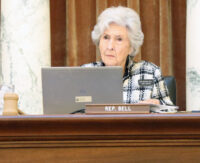In a frenzy of activity Monday, legislative budget-writers approved a 5.9 percent increase in public school funding, sending the budget off to the rest of the Legislature with a mandate of bipartisan support behind it.
It took the Joint Finance-Appropriations Committee less than an hour to approve the seven public school budgets, which together represent about 48 percent of state general fund spending.
Voting 19-0 each time, JFAC approved spending $100 million above current K-12 funding in 2018-19, with total general fund spending reaching nearly $1.8 billion.
The largest item driving new spending is nearly $41.7 million to provide teachers and educators a fourth year of raises under the career ladder law.
Despite JFAC’s unanimous agreement, budget writers diverged from recommendations from Gov. Butch Otter and Superintendent of Public Instruction Sherri Ybarra. Ybarra had requested a 6.8 percent increase, while Otter pushed a 6 percent increase. In the end, JFAC settled on a 5.9 percent increase.
The $13 million difference between her budget recommendation and the budget JFAC set Monday didn’t faze Ybarra.
“It’s great, it’s another $100 million increase for public schools,” Ybarra said. “We have a plan to follow and we’re all on the same page. Education is a priority again.”
Budget highlights include:
- $41.7 million for raises for teachers and educators.
- A $32 million deposit into the Public Education Stabilization Fund, a rainy-day savings account.
- $10.5 million in new spending for classroom technology.
- $7.2 million in new spending to help school districts pay for employees’ health care costs.
- $4 million in new spending to increase the share of discretionary spending for school districts. Many people refer to discretionary spending as “operations funding” instead.
- $2 million in new spending for college and career advisers.
- $1.7 million in new spending for literacy proficiency.
- $1.6 million in new spending to invest in education content and curriculum.
- $1 million in new spending to benefit students with limited English proficiency.

JFAC co-chairwoman Maxine Bell, a Jerome Republican who is the Legislature’s longest-serving member with 15 terms under her belt, said it is unusual to see the K-12 budget set so quickly, without any real debate or competing plans.
“It’s like Thanksgiving dinner, but we never saw them chase the turkey or pluck the turkey,” Bell joked, saying JFAC cooked up a “tasty” school budget.
Bell attributed the widespread agreement to the behind-the-scenes homework several legislators put in this session to develop the budget and build consensus. Overall, Bell said legislators used the 20 recommendations from Otter’s Task Force for Improving Education issued in 2013 as a blueprint for the budgets.
One of JFAC’s biggest decisions was to set aside $7.2 million to help schools cover health care expenses. Otter had recommended no new funding in that area.
“We stayed in touch with our local districts and charters and really made sure we are trying to reflect their concerns in this budget,” said Idaho Falls Republican Rep. Wendy Horman, who took a leading role in writing the budget. “That’s why you saw a very collaborative process come together here.”
Notably, JFAC requested independent evaluations or audits of several programs that will receive funding. Legislators called for an independent, external audit of the state’s literacy intervention programs and college and career advising programs. A separate audit of a new reading test school districts are piloting is already in the works.
Last week, in briefing JFAC, House Education Committee Chairwoman Julie VanOrden, R-Pingree, said the state just hasn’t seen enough data to know how well some of its recent education initiatives are working.
Horman agreed.
“By return on investment, I mean student outcomes — are we seeing improvements in the outcomes for our students?” Horman said. “If we are, great, let’s do more of that. If we aren’t, let’s refine the programs.”
Ybarra said she was comfortable with the reviews. “I don’t blame folks for wanting to see their return of that investment.”
Despite widespread agreement, JFAC members opted not to provide funding for two proposals.
JFAC did not fund a $1.4 million request to expand the state’s mastery-based education pilot program because a companion policy bill has yet to advance out of the House Education Committee, where it was introduced. JFAC also declined to fund a $433,800 request to replace the Idaho Reading Indicator test, saying the state has yet to review an external audit of IRI pilot test.
Even though JFAC set the budget Monday, the budget still must win approval on the House and Senate floors in the coming weeks, and then avoid Otter’s veto. K-12 education spending is Idaho’s largest general fund expense each year, and is expected to account for more than 48 percent of all general fund spending next year.
Further reading: The public school budgets call for ending the controversial statewide WiFi contract in favor of allowing school districts and charters to cut their own deals locally.
